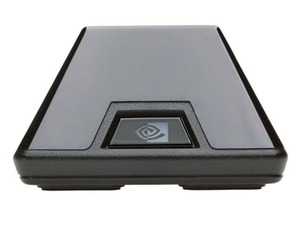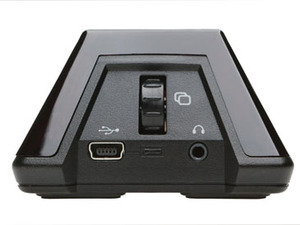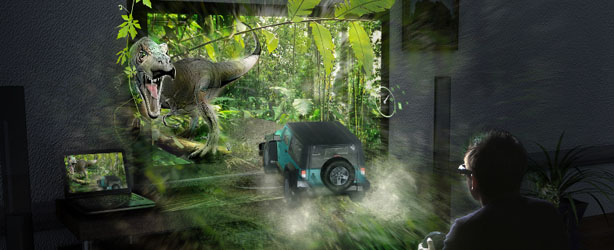
BT: 3D Vision uses Nvidia 3D glasses and USB emitters, while AMD's HD3D system uses glasses that come with the TV and third-party 3D middleware. AMD says its system eliminates USB latency, and also ensures the glasses are properly synchronised with the TV. What are the advantages of a tied-in system such as 3D Vision?
AF: Well, let's first of all comment on USB latency. For about six months we've been working with notebook and display manufacturers to integrate embedded emitters directly inside products. Notebooks started shipping with embedded emitters in November last year, and Acer's already shipping embedded-emitter monitors. There are no USB latency issues with these.
Phil Eisler: Latency isn't really a problem for the emitter anyway. The emitter is fundamentally just sending out a clock signal, and we actually have a flywheel on the glasses so it doesn't need a signal very often. It's just comparing the sync and making minor adjustments to keep the timing in line, and it just needs a tick from the system every second or so to adjust the synchronisation.
BT: Would an embedded emitter work with any 3D shutter glasses, or just 3D Vision glasses?
AF: We design embedded emitters for our glasses, because we focus on making a high quality experience. In our experience, if you try to take the model of ten years ago, throw 3D to the wind and say 'please make glasses for us,' and hope it all works together, then the end result isn't a good experience. You get glasses with different ghosting characteristics, glasses that have faulty lenses – lots of different problems. It would be like Apple saying it was going to build an iPod, but it was going to rely on someone else to build iTunes and count on Warner Brothers to provide the music. That model just doesn't make a lot of sense.
BT: AMD also says there are benefits to the open nature of HD3D, though. Its driver will work with any HDMI 1.4a TV without needing any specific hardware.
AF: We have two different product offerings - 3DTV Play and 3D Vision. So we do have a driver architecture that allows you to connect a GeForce GPU to an HDMI 1.4a TV – you can use the glasses that come from the manufacturer – Panasonic, LG, Samsung – whatever it is. We sell that software online, and it enables you to access 3D games, our streaming capability and our photo-viewing capability – all the features that we're doing.
So we're exactly the same as AMD, and in fact we're better I would say, because in order to do that on AMD you have to find a third-party driver from DDD or iZ3D that makes it all work. We make the driver ourselves, so in some ways we have a better strategy, because we're responsible for the drivers. If you've got a problem with your game, you can just come direct to Nvidia – we make the graphics cards, the 3D drivers and we work with the game developers. If you're buying an AMD solution, who do you call when you've got a problem with your game - DDD or AMD?
With 3D Vision, we make everything, so both end users and OEMs know who to come to when there's a problem. I think AMD's strategy is a little bit different – as an OEM you'd have to go to maybe three or four people to try to resolve your problem.
BT: AMD says that HD3D works on both HDMI 1.4a and DisplayPort. However, 3D Vision doesn't support 3D over DisplayPort yet. Are there any plans to support DisplayPort in the future?
AF: Well, we don't support DisplayPort because no monitors are built to support it yet and, to be honest with you, the problem with DisplayPort today is that the number of GPUs sold with it is pretty limited. The fact is there are 150 million GPUs that support dual-link DVI – every single GPU since the GeForce 8-series supports dual-link DVI. So if you're going to try to build a monitor with DisplayPort, you've got to tell every single customer that owns a dual-link DVI GPU to buy this $100 dongle to convert from DVI to DisplayPort.
But I would imagine in the future that 3D Vision monitors may include a DisplayPort connector, and we certainly aren't preventing it, it's just that there hasn't been strong demand for it.
BT: 3D Vision specifically uses active shutter glasses, but some companies such as Oakley say that passive glasses are superior for a number of reasons. Why are you solely using active glasses, and would you consider using passive glasses in the future?
AF: The market is certainly trying to create a format war between active and passive, and to be honest I don't believe there is a format war – it's kind of silly. They try to raise the analogy between formats like Blu-Ray and HD-DVD, but with active vs passive it really doesn't matter – it's like asking if you want to view your movie on a projector or a big-screen TV – the input that gets it there is the same.
AF: Well, let's first of all comment on USB latency. For about six months we've been working with notebook and display manufacturers to integrate embedded emitters directly inside products. Notebooks started shipping with embedded emitters in November last year, and Acer's already shipping embedded-emitter monitors. There are no USB latency issues with these.
Phil Eisler: Latency isn't really a problem for the emitter anyway. The emitter is fundamentally just sending out a clock signal, and we actually have a flywheel on the glasses so it doesn't need a signal very often. It's just comparing the sync and making minor adjustments to keep the timing in line, and it just needs a tick from the system every second or so to adjust the synchronisation.
BT: Would an embedded emitter work with any 3D shutter glasses, or just 3D Vision glasses?
AF: We design embedded emitters for our glasses, because we focus on making a high quality experience. In our experience, if you try to take the model of ten years ago, throw 3D to the wind and say 'please make glasses for us,' and hope it all works together, then the end result isn't a good experience. You get glasses with different ghosting characteristics, glasses that have faulty lenses – lots of different problems. It would be like Apple saying it was going to build an iPod, but it was going to rely on someone else to build iTunes and count on Warner Brothers to provide the music. That model just doesn't make a lot of sense.
BT: AMD also says there are benefits to the open nature of HD3D, though. Its driver will work with any HDMI 1.4a TV without needing any specific hardware.
AF: We have two different product offerings - 3DTV Play and 3D Vision. So we do have a driver architecture that allows you to connect a GeForce GPU to an HDMI 1.4a TV – you can use the glasses that come from the manufacturer – Panasonic, LG, Samsung – whatever it is. We sell that software online, and it enables you to access 3D games, our streaming capability and our photo-viewing capability – all the features that we're doing.
So we're exactly the same as AMD, and in fact we're better I would say, because in order to do that on AMD you have to find a third-party driver from DDD or iZ3D that makes it all work. We make the driver ourselves, so in some ways we have a better strategy, because we're responsible for the drivers. If you've got a problem with your game, you can just come direct to Nvidia – we make the graphics cards, the 3D drivers and we work with the game developers. If you're buying an AMD solution, who do you call when you've got a problem with your game - DDD or AMD?
With 3D Vision, we make everything, so both end users and OEMs know who to come to when there's a problem. I think AMD's strategy is a little bit different – as an OEM you'd have to go to maybe three or four people to try to resolve your problem.
BT: AMD says that HD3D works on both HDMI 1.4a and DisplayPort. However, 3D Vision doesn't support 3D over DisplayPort yet. Are there any plans to support DisplayPort in the future?
AF: Well, we don't support DisplayPort because no monitors are built to support it yet and, to be honest with you, the problem with DisplayPort today is that the number of GPUs sold with it is pretty limited. The fact is there are 150 million GPUs that support dual-link DVI – every single GPU since the GeForce 8-series supports dual-link DVI. So if you're going to try to build a monitor with DisplayPort, you've got to tell every single customer that owns a dual-link DVI GPU to buy this $100 dongle to convert from DVI to DisplayPort.
But I would imagine in the future that 3D Vision monitors may include a DisplayPort connector, and we certainly aren't preventing it, it's just that there hasn't been strong demand for it.
BT: 3D Vision specifically uses active shutter glasses, but some companies such as Oakley say that passive glasses are superior for a number of reasons. Why are you solely using active glasses, and would you consider using passive glasses in the future?
AF: The market is certainly trying to create a format war between active and passive, and to be honest I don't believe there is a format war – it's kind of silly. They try to raise the analogy between formats like Blu-Ray and HD-DVD, but with active vs passive it really doesn't matter – it's like asking if you want to view your movie on a projector or a big-screen TV – the input that gets it there is the same.

MSI MPG Velox 100R Chassis Review
October 14 2021 | 15:04











Want to comment? Please log in.